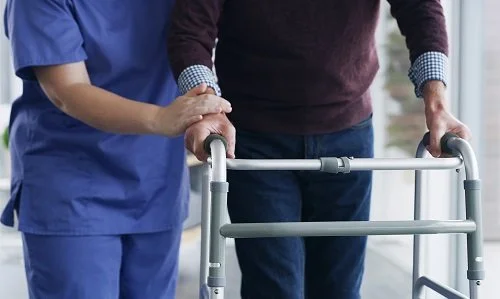How to make sure your falls prevention program is working
Falls are a major concern for individuals with mobility challenges, whether in the community, at home, or in aged care facilities.
A well-designed falls prevention program is essential for improving strength, balance, and safety. But how do you know if your program is working?
Whether you’re supporting patients in aged care or working with NDIS participants, it's crucial to ensure your falls prevention program is tailored to their needs and making a positive impact.
Key components of an effective falls prevention program
A successful falls prevention program is more than just exercises, it’s about a holistic approach that incorporates:
Strength and balance exercises: These exercises are fundamental for improving coordination and muscle strength, which reduces the risk of falls. Activities like leg strengthening, balance training, and gait training should be part of the regular program.
Home modifications: For NDIS patients, home modifications are key to reducing fall risks. Ramps, grab bars, and widened doorways can help create a safer environment, allowing individuals to move freely and independently while minimising hazards.
Physiotherapy support: Physiotherapists play a pivotal role in assessing a patient’s mobility and developing a tailored falls prevention plan. Regular sessions can help patients improve posture, gait, and muscle strength, all of which are essential for fall prevention.
Assessing your falls prevention program
It’s important to evaluate whether the program is effective in achieving its goals. Here’s how you can assess progress:
Track improvements in strength and balance: Keep an eye on the patient’s ability to perform balance tests, walk longer distances, and perform exercises without discomfort.
Monitor fall incidents: The ultimate goal is to reduce fall incidents. If falls are still happening, it’s a sign that adjustments may be necessary, whether in the exercises, home environment, or overall care plan.
Feedback from support workers: For those in aged care or receiving NDIS support, case managers and support workers play a vital role in observing daily activities and noting any challenges with mobility. Feedback from these individuals can provide valuable insights.
Common mistakes to avoid
A falls prevention program is only effective if it’s properly executed. Some common mistakes to avoid include:
Not customising the program: Each patient is unique. NDIS participants, particularly those with conditions like MS, need a tailored approach that addresses their specific mobility challenges. A one-size-fits-all program won’t work.
Neglecting regular reviews: A program that works today might not be effective in a few months. Regular assessments are necessary to adjust the program as the individual’s needs evolve.
Overlooking emotional support: Falling can be mentally and emotionally distressing. Supporting mental health and providing encouragement can help patients stay motivated and engaged in their falls prevention journey.
Falls prevention in aged care facilities
For aged care patients in nursing homes, support workers and nurses play a critical role in implementing falls prevention strategies. This includes:
Assistive devices: Using mobility aids like walking frames or wheelchairs can help patients maintain stability and reduce fall risks.
Environmental safety: In nursing homes, ensuring that the environment is clear of obstacles and that walking paths are well-lit and unobstructed is essential for preventing falls.
Did you know?
Falls often happen when and where you least expect them. Preventing falls isn’t just
about exercise.
There are many hidden factors that increase your risk:
Most falls occur in your own home, where you feel comfortable and safe. Everyday hazards like loose rugs, poor lighting, and cluttered walkways are common causes.
Footwear matters. Poorly fitting or slippery shoes can increase your risk of slips, trips, and falls.
Medications can increase fall risk. Certain medicines can cause dizziness, drowsiness, or balance problems especially when taking multiple medications at once.
Vitamin D plays a role. Low vitamin D can weaken muscles and bones, making falls and fractures more likely.
Vision is critical. Even minor changes in eyesight can affect depth perception and balance. Regular vision checks are important part of a falls prevention program
Hearing loss can contribute. Difficulty hearing environmental cues can make navigation less safe.
Low blood pressure (postural hypotension). Standing up quickly can cause dizziness or light-headedness, leading to falls.
Chronic health conditions. Conditions like Parkinson’s disease, arthritis, diabetes, or stroke can affect balance, strength, and sensation.
Muscle weakness and deconditioning. Reduced strength, especially in the legs, is a major risk factor for falls.
Balance problems. Neurological conditions, inner ear disorders, or ageing itself can affect your ability to stay steady.
Previous falls. Having had a fall before greatly increases the risk of falling again.
Alcohol use. Even moderate drinking can impair balance and reaction time.
Ongoing support for long-term success
An effective falls prevention program requires ongoing support and adjustments. At Lifespan Therapy Services we work alongside support workers and case managers to provide consistent care, regular reviews, and necessary updates to the program to maintain its success over time.
Unsure if your falls prevention program is effective?
Contact our team today for expert guidance and personalised recommendations to improve your safety and wellbeing.



